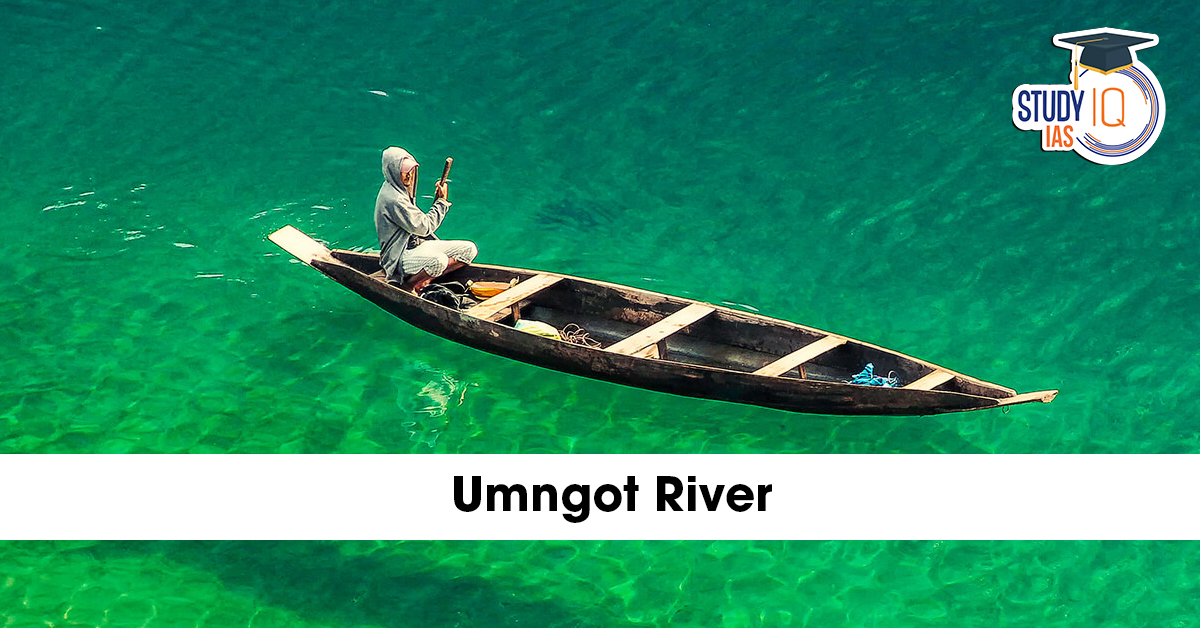Table of Contents
The Umngot River in Meghalaya, famed for its crystal-clear waters that make boats appear to float on air, has turned murky and brown, sparking alarm among locals, environmentalists, and tourists alike.
Flowing through the West Jaintia Hills district, the river has long been a symbol of Meghalaya’s natural beauty and a cornerstone of its tourism economy.
This sudden discoloration, observed since October 2025, coincides with the Shillong–Dawki Highway construction project undertaken by the National Highways and Infrastructure Development Corporation Limited (NHIDCL) — raising serious environmental concerns.
About the Umngot River
| Feature | Details |
|---|---|
| Location | West Jaintia Hills, Meghalaya |
| Major Settlements | Dawki, Shnongpdeng |
| Source | Near the India–Bangladesh border |
| Length | Approx. 90 km |
| Tributary of | Umngot joins the Meghna River in Bangladesh |
| Fame | Known for its transparent waters that make the riverbed visible even at great depth |
Often described as “Asia’s cleanest river”, the Umngot has become a tourism icon, featuring in travel campaigns, photography journals, and environmental studies for its unique water clarity.
Tourism Significance
The towns of Dawki and Shnongpdeng, perched along the Umngot, are among Meghalaya’s top travel destinations.
Popular activities include:
-
Boating and kayaking in crystal-clear water
-
Camping on riverbanks
-
Nature photography and eco-tourism
-
Viewing the Dawki Suspension Bridge
During winter (October–February), thousands of visitors flock to witness the mirror-like surface of the river, which reflects the surrounding hills and sky — a spectacle that has now been disrupted by murky water conditions.
The Problem: Umngot River Turns Murky
This year, even as the monsoon ended, the Umngot River failed to regain its clarity.
Local residents reported that the water remains opaque and brown, disappointing tourists and threatening the local economy.
According to residents and environmental groups, the cause lies in hill-cutting, soil dumping, and bridge construction related to the Shillong–Dawki two-lane road project.
“The Umngot used to turn clear by mid-October, but this year, the silt hasn’t settled. Tourists are leaving disappointed,”
said a local campsite owner in Shnongpdeng.
The Shillong–Dawki Highway Project
The 81-km Shillong–Dawki highway, being upgraded by NHIDCL, began construction in May 2024.
The project includes:
-
A 10-meter carriageway
-
A 400-meter-long bridge over the Umngot River, 100 meters above the surface
-
Road widening, hill-cutting, and infrastructure development along the riverbanks
While aimed at improving trade routes between India and Bangladesh, the project has allegedly caused massive dumping of soil and debris into nearby water systems.
Official Reactions and Investigations
The issue has drawn political and administrative attention:
-
Ricky Syngkon, Shillong MP (Voice of the People Party), wrote to Union Ministers Nitin Gadkari and Bhupender Yadav, calling the situation an “ecological disaster.”
-
Lahkmen Rymbui, Meghalaya Cabinet Minister, confirmed that the state government has taken cognizance and directed NHIDCL to take corrective measures.
-
The Meghalaya State Pollution Control Board (MSPCB) conducted an inspection and found:
-
Uncontrolled dumping of excavated soil along roadsides
-
Filling materials sliding into the river due to lack of containment
-
Absence of erosion control measures
-
MSPCB instructed NHIDCL to:
-
Follow SOPs for construction waste management
-
Remove debris from the riverbanks
-
Stabilize slopes and control sedimentation
Environmental Impact
Experts warn that the murkiness poses long-term risks to the Umngot’s fragile ecosystem:
-
Sedimentation destroys aquatic habitats and reduces oxygen levels.
-
Water quality degradation affects local fisheries and biodiversity.
-
Tourism decline threatens livelihoods in Shnongpdeng and Dawki.
-
Soil erosion could alter the river’s flow and impact nearby settlements.
“If this continues, Umngot’s self-cleansing capacity will be permanently reduced,”
said an environmental scientist from North-Eastern Hill University (NEHU).
Economic Impact on Local Communities
Tourism is the economic backbone for thousands of locals in the Dawki–Shnongpdeng belt.
Activities such as boating, homestays, adventure sports, and food stalls are being directly affected.
Reports indicate a sharp decline in tourist arrivals this October due to the river’s discoloration.
Local operators fear that if conditions persist, the winter tourist season — the most profitable period — could be ruined entirely.
Way Forward: Restoring the Umngot
-
Immediate Clean-up Operations: Remove dumped soil and debris from riverbanks.
-
Eco-Friendly Construction Practices: Use sediment traps, silt fences, and controlled dumping.
-
Continuous Monitoring: Conduct monthly water quality tests under MSPCB supervision.
-
Community Involvement: Empower locals to report violations and assist in restoration.
-
Tourism Regulation: Enforce sustainable tourism guidelines to preserve river ecology.
The Umngot as a Symbol of Sustainability
The Umngot River stands as a reminder that development and ecology must coexist.
While infrastructure projects are vital, ignoring environmental safeguards can destroy natural assets that sustain local economies and cultural heritage.
As Meghalaya celebrates its natural wealth, protecting the Umngot River must become a priority — ensuring that its emerald waters flow clear again for generations to come.


 100 Years of Indian Hockey: Celebrating ...
100 Years of Indian Hockey: Celebrating ...
 BRICS Pay: The New Global Payment Revolu...
BRICS Pay: The New Global Payment Revolu...
 International Migration Outlook 2025: Ke...
International Migration Outlook 2025: Ke...

























